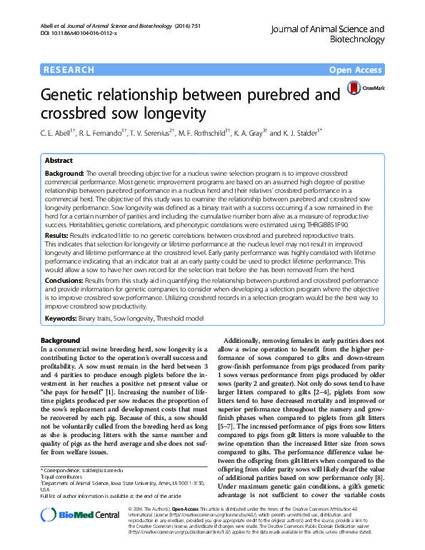
Background
The overall breeding objective for a nucleus swine selection program is to improve crossbred commercial performance. Most genetic improvement programs are based on an assumed high degree of positive relationship between purebred performance in a nucleus herd and their relatives’ crossbred performance in a commercial herd. The objective of this study was to examine the relationship between purebred and crossbred sow longevity performance. Sow longevity was defined as a binary trait with a success occurring if a sow remained in the herd for a certain number of parities and including the cumulative number born alive as a measure of reproductive success. Heritabilities, genetic correlations, and phenotypic correlations were estimated using THRGIBBS1F90. Results
Results indicated little to no genetic correlations between crossbred and purebred reproductive traits. This indicates that selection for longevity or lifetime performance at the nucleus level may not result in improved longevity and lifetime performance at the crossbred level. Early parity performance was highly correlated with lifetime performance indicating that an indicator trait at an early parity could be used to predict lifetime performance. This would allow a sow to have her own record for the selection trait before she has been removed from the herd. Conclusions
Results from this study aid in quantifying the relationship between purebred and crossbred performance and provide information for genetic companies to consider when developing a selection program where the objective is to improve crossbred sow performance. Utilizing crossbred records in a selection program would be the best way to improve crossbred sow productivity.
Available at: http://works.bepress.com/max-rothschild/161/

This article is published as Abell, C. E., R. L. Fernando, T. V. Serenius, M. F. Rothschild, K. A. Gray, and K. J. Stalder. "Genetic relationship between purebred and crossbred sow longevity." Journal of animal science and biotechnology 7 (2016): 51. doi: 10.1186/s40104-016-0112-x. Posted with permission.